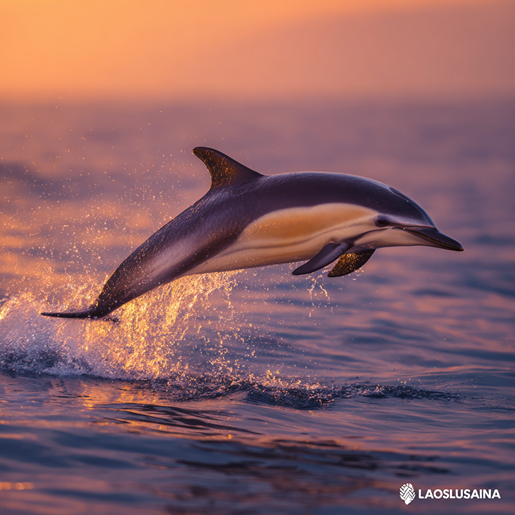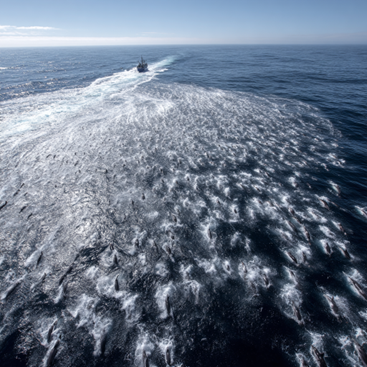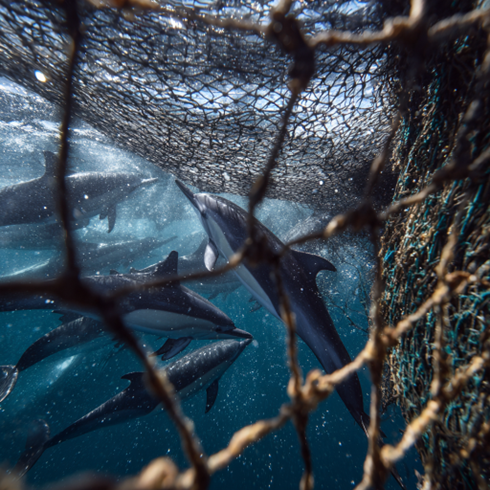Common Dolphin
The Paradox of the Common
The Common Dolphin, with its distinctive hourglass pattern of gold and grey along its flanks, is perhaps the most recognizable cetacean in the world—the archetypal "dolphin" of ancient art, Renaissance frescoes, and modern imagination. These exuberant, fast-swimming dolphins form some of the largest aggregations of any marine mammal on Earth, with super-pods numbering in the thousands that create a spectacle of leaping, surfing, and vocalization visible for miles.
Yet this "commonness" has become a curse. While rare species attract conservation attention precisely because of their scarcity, the Common Dolphin suffers from a paradox of abundance—their global numbers create a false sense of security that obscures the regional extinctions unfolding in real time. In the Mediterranean and Black Seas, populations have collapsed. In the Bay of Biscay, thousands die annually in fishing nets. The very visibility and numerical abundance that make them seem secure have made them targets for industrial-scale killing, both historical and ongoing.

A super-pod of common dolphins—exuberant, fast-swimming, and impossibly graceful. Their joy is visible, their presence undeniable, and their vulnerability profound.
Masters of Speed and Joy
Common dolphins are built for speed, with sleek, streamlined bodies ranging from 5.5 to 8.5 feet (1.7 to 2.6 meters) and weighing 150 to 300 pounds (70 to 135 kg). Their distinctive coloration—a criss-cross hourglass pattern of tan and grey on the flanks, a dark cape along the back, and a white belly—makes them unmistakable.
They are among the fastest cetaceans, capable of sustained speeds over 25 mph with bursts exceeding 30 mph. They are prodigious bow-riders, surfing the pressure waves of ships with what can only be described as joy. Their aerial acrobatics—leaps, flips, and spins—are not merely functional but expressive, a visible manifestation of vitality and pleasure.
Common dolphins are highly social, living in fluid fission-fusion societies where pod composition changes frequently. They communicate through a complex repertoire of whistles, clicks, and burst-pulse sounds. They hunt cooperatively, herding schools of small fish and squid into tight balls before feeding in coordinated rushes.

Common dolphins bow-riding—an expression of pure joy, a refusal to hide, a willingness to engage with the very vessels that represent their greatest threat.
Sacred Swimmers of the Ancient World
In the ancient Mediterranean, the Common Dolphin was not merely an animal—it was a divine messenger, a psychopomp, a carrier of souls between worlds. Greek and Roman mythology is saturated with dolphin imagery: dolphins rescued the poet Arion from drowning, carried the god Dionysus safely across the sea, and guided lost sailors to shore.
Plutarch wrote that dolphins possessed intelligence and benevolence surpassing all other creatures. Pliny the Elder described dolphins as friends of humanity, drawn to music and the voices of children. To kill a dolphin was considered an act of murder, punishable by death in some Greek cities.
This sacred status persisted for millennia. Yet as the Mediterranean industrialized, the ancient reverence was forgotten. The creature that once symbolized divine protection became collateral damage in the relentless extraction of marine resources.

The grim reality—thousands of common dolphins wash ashore annually on French beaches, victims of bycatch in the Bay of Biscay's industrial fisheries.
Regional Catastrophes: The Mediterranean and Black Sea
The Black Sea Slaughter
Between 1940 and the early 1980s, the Soviet Union conducted one of the largest and most systematic slaughters of marine mammals in history. In the Black Sea alone, over 900,000 common dolphins were killed—shot, harpooned, and netted—for their blubber, which was rendered into industrial lubricant and lamp oil.
This industrial slaughter averaged 21,000 dolphins per year—57 per day, more than 2 per hour, every hour, for four decades. The population, once thought to number over a million, collapsed and has never recovered. The Black Sea, once alive with dolphin super-pods, became a killing field.
Today, the survivors face ongoing threats of prey depletion from overfishing and continued bycatch in fishing nets. The Black Sea common dolphin is now classified as Endangered, a shadow population in a degraded sea.
The Mediterranean Collapse
In the Mediterranean, the collapse has been even more complete. Once abundant throughout the sea, common dolphins have virtually disappeared from the eastern and central basins. The western Mediterranean—particularly the Gulf of Lions and the waters around the Balearic Islands—holds the last significant populations.
The causes are multifaceted: overfishing has devastated prey populations; pollution has contaminated the food web; acoustic disturbances from shipping and naval exercises interfere with echolocation and communication. But the immediate cause of death, again and again, is bycatch—dolphins tangled and drowned in nets set for tuna, swordfish, and other commercial species.
The Bay of Biscay: Modern Bycatch Hotspot
The Bay of Biscay, located off the coasts of France and Spain, is a modern bycatch hotspot where thousands of common dolphins die annually in pelagic trawl fisheries targeting sea bass and hake. In 2017 alone, over 10,000 dolphins were estimated to have been killed—far exceeding sustainable levels.
Despite being within EU waters with strong environmental regulations, enforcement remains weak, and the killing continues. The dolphins' hourglass-patterned bodies wash ashore on French beaches each winter, a grim testament to the ongoing crisis. Recent research has shown that female longevity has declined dramatically, and the Bay of Biscay population is now functioning as a demographic sink—deaths exceed births, sustained only by immigration from healthier populations.
Connection to the South: Joy, Visibility, and Vulnerability
In the Medicine Wheel's South direction, the Common Dolphin represents the purest expression of visible emotion—joy in motion, exuberance made manifest. Their super-pods are not merely feeding aggregations but celebrations of life, their leaps not just practical behaviors but expressions of something we can only call happiness. This is the energy of the South: emotional openness, the courage to be seen, the refusal to hide one's inner light.
Yet this openness, this constant presence at the surface of both water and human consciousness, has made them exceptionally vulnerable. They are too visible, too numerous, too "common" to be perceived as precious. While rare species attract conservation attention precisely because of their scarcity, the Common Dolphin suffers from a paradox of abundance—their global numbers create a false sense of security that obscures the regional extinctions unfolding in real time.
The South teaches us that emotional openness requires courage, and that the most joyful among us are often the most exposed to harm. The Common Dolphin's willingness to live at the intersection of human and marine worlds, to leap into visibility again and again, to express joy without reservation—these are not signs of naivety but of profound spiritual strength. The dolphins continue to dance at the surface even as the nets close around them, continue to play even in poisoned waters, continue to express their essential nature even when that nature has made them targets.
The story of the Common Dolphin is ultimately a mirror held up to humanity. In our collective imagination, it remains the sacred, benevolent friend—the psychopomp, the soul-carrier, the divine messenger. In the ocean, however, it has become a victim of our most destructive practices. The fate of the Mediterranean and Black Sea populations serves as a critical warning: even the most "common" of creatures can be pushed toward regional extinction when its habitat is relentlessly degraded and its life is treated as collateral damage. To honor the South's teaching is to protect those who dare to be visible, to celebrate joy, and to recognize that commonness should never be confused with expendability.
References
- IUCN Red List. Delphinus delphis. https://www.iucnredlist.org/species/6336/50285313
- Peltier, H. et al. Assessing the impact of bycatch on dolphin populations: The case of the common dolphin in the eastern North Atlantic. PLOS ONE 7(2): e32615 (2012). https://pmc.ncbi.nlm.nih.gov/articles/PMC3290591/
- Rouby, E. et al. Longevity collapse in dolphins: A growing conservation concern in the Bay of Biscay. Conservation Letters (2025). https://conbio.onlinelibrary.wiley.com/doi/10.1111/conl.13142
- Murphy, S. et al. Importance of biological parameters in assessing the status of Delphinus delphis. Marine Ecology Progress Series 388: 273-291 (2009). https://www.int-res.com/abstracts/meps/v388/p273-291/
- Bearzi, G. et al. Prey depletion caused by overfishing and the decline of marine megafauna in eastern Ionian Sea coastal waters (central Mediterranean). Biological Conservation 127(4): 373-382 (2006). https://www.sciencedirect.com/science/article/abs/pii/S0006320705002989
- Birkun Jr., A. Delphinus delphis ssp. ponticus. IUCN Red List of Threatened Species 2012: e.T133616A4306963. https://www.iucnredlist.org/species/133616/4306963
- ICES. EU request on mitigation measures to reduce bycatches of common dolphin in the Bay of Biscay (2023). https://ices-library.figshare.com/articles/report/EU_request_on_mitigation_measures...
- Sea Watch Foundation. Common Dolphin. https://www.seawatchfoundation.org.uk/common-dolphin/
- Whale and Dolphin Conservation. Common Dolphin. https://us.whales.org/whales-dolphins/species-guide/common-dolphin/
- The Guardian. Thousands of dolphins are being killed in nets in the Bay of Biscay. January 26, 2020. https://www.theguardian.com/environment/2020/jan/26/thousands-dolphins-killed-nets-bay-biscay